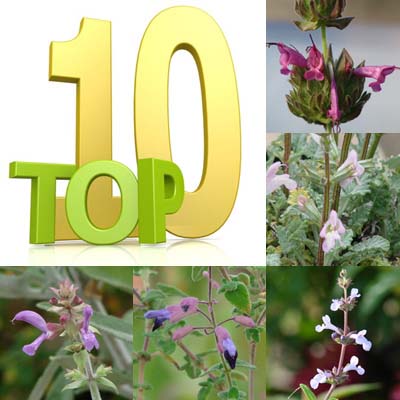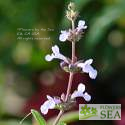Praise for Top 10 Lesser-Known Drought-Resistant Salvias

Eco-vigilantes. That's what some newspapers call smartphone users who post photos and videos tagged droughtshaming on Twitter and other social media. These activists snap pictures of careless or excessive water use by celebrities, everyday homeowners and businesses, especially in drought-parched Southern California. Some include addresses in their posts; others send photos via smartphone directly to governmental water authorities.
But broadcast and digital producer Harriet Ells, a habitué of Los Angeles and Twitter, has transformed this practice into what we see as a friendlier way of encouraging water conservation.
While house hunting, Ells began photographing pretty, drought-tolerant gardens, which she posts on Twitter with the hashtag "#droughtpraise." It's a positive kind of finger-pointing that encourages property owners to do the right thing by replacing thirsty landscaping with low-water plantings.
At Flowers by the Sea, we greatly admire the resilience of the mint family (Lamiaceae) and its many kinds of waterwise species, particularly its Salvia genus. Here is some praise for the drier side of the genus.
Droughtpraise for Hairy, Silvery Sages
Many Salvias are well known as being pretty, fragrant plants that need little-to-no supplemental watering. These species include the California native Cleveland Sage (Salvia clevelandii), which has become a dry garden favorite from San Luis Obispo on California's central coast south to San Diego.
Yet many of the most drought-resistant species in the genus are not well known. More often than not, these plants have gray-green, silvery or whitish-green foliage. The muted colors are partly due to the hairiness of the plants' leaves and stems.
Hairy foliage is one of nature's coping mechanisms for helping plants survive and even thrive in dry climates and during drought. Sometimes the hairs are coarse; sometimes they're fine and difficult to see unless the sun is glinting on them. Often, they create a velvety leaf texture.
The quickest way to locate some of these sages in our online catalog is to select the Salvias by Color category in our product menu -- the broad, green band near the top of each page -- and then click on the subcategory Gray & Silver Leaf.
Let Us Now Praise Not-So-Famous Sages
As promised in the title of this article, we've going to introduce you to ten of our favorite, little-known, drought-resistant Salvias. They include perennials, shrubs and subshrubs -- ones that combine both tender perennial and woody, shrub-like growth.
Aside from their undemanding nature regarding water, these plants generally need low-fertility soils that drain well, so gravelly ground works for them. Most sages don't do well with persistently damp roots, especially extremely drought-resistant species.
We've divided our list by U.S. Department of Agriculture Plant Hardiness Zones, which are based on average minimum winter temperatures. Plants are classified as being hardy to zones in which their roots can survive winter chill.
The range of temperatures among the sages in this article are likely to withstand lows ranging from -20 degrees F in Zone 5 to 20 degrees F in Zone 9.
Also, many of the plants in this list attract one or more pollinators, so these are great choices for wildlife gardens focused on feeding hummingbirds, bees, butterflies and other beneficial insects. Deer, however, leave these plants alone.
Hardy to Zone 5
Lilac Sage (Salvia verticillata) Zones 5 to 9
- Lavender flowers bloom spring to summer
- Fragrant mint green foliage
- 36 inches tall in bloom, 42 inches wide
- Full sun to partial shade
- Cold- and heat-tolerant perennial
- Honeybees and butterflies
Hardy to Zone 6
Turkish Tea Sage (Salvia aucheri) Zones 6 to 9
- Lavender flowers bloom summer to fall
- Fragrant, mid-green foliage
- 24 inches tall in bloom, 18 inches wide
- Full Sun
- Cold- and heat-tolerant subshrub
- Honeybees
Hardy to Zone 7
Pacific Blue Sage (Salvia brandegei x munzii 'Pacific Blue') Zones 7 to 9
- Lavender blue flowers bloom
- Fragrant, dark green leaves with have fuzzy, white undersides
- 48 inches tall in bloom, 36 inches wide
- Full sun
- Heat-tolerant shrub
- Honeybees and hummingbirds
Kashmir Sage (Salvia moorcroftiana) Zones 7 to 9
- Lilac-blue flowers bloom spring to summer
- Fragrant, gray-green foliage
- 36 inches tall and 24 inches wide in bloom
- Full sun
- Heat-tolerant
- Butterflies and honeybees
Marine Blue Sage (Salvia x chamaedryoides 'Marine Blue') Zones 7 to 11
- Cerulean blue flowers bloom summer to fall
- Fragrant, wooly leaves silver on top and white on the bottom
- 24 inches tall, 36 inches wide
- Full sun
- Heat-tolerant perennial groundcover
Dandelion Leaf Sage (Salvia taraxacifolia) Zones 7 to 11
- Pale pink flowers bloom
- Fragrant, gray-green foliage
- 12 inches tall and wide in bloom
- Full sun
- Heat-tolerant, perennial groundcover
Santa Rosa Island Sage (Salvia brandegeei) Zones 7 to 9
- Lavender flowers bloom winter to spring
- Deep green, wrinkly, fragrant foliage
- 48 inches tall in bloom, 36 inches wide
- Full sun
- Honeybees
Hardy to Zone 8
Lancelot Wooly Canary Sage (Salvia canariensis 'Lancelot') Zones 7 to 11
- Lavender flowers bloom summer to fall
- Silvery green leaves with velvety white undersides
- Deep rosy bracts
- 48 inches tall in bloom, 30 inches wide
- Full sun
- Heat-tolerant subshrub
- Butterflies and honeybees
Pine Mountain Sage (Salvia semiatrata) Zones 8 to 11
- Violet and purple flowers with pink bracts
- Gray-green foliage
- 48 inches tall in bloom, 36 inches wide
- Full sun
- Groundcover shrub
- Honeybees and hummingbirds
Hardy to Zone 9
Kirstenbosch Golden Sage (Salvia africana-lutea 'Kirstenbosch') Zones 9 to 11
- Yellow to rusty orange flowers bloom spring to fall
- Fragrant, wooly, gray-green leaves
- 48 inches tall and wide in bloom
- Full Sun
- Heat-tolerant perennial
- Butterflies
Questions About Planning a Low Water Garden
Persistent drought calls for a persistent pursuit of low-water, or xeric, solutions in the garden. Nevertheless, when planting drought-resistant species, you need to water them regularly until their roots become established. Once established, some species may almost never need watering. Deep watering, by drip line or by hand, should be done around the base of new plantings during cooler times of day to limit evaporation.
Background on xeriscaping -- the art of low-water gardening -- is detailed in the Xeric Choices story queue of our Everything Salvias Blog. Links to information about how to remove lawn so you can replace it with low-water plantings is available in the Turf Removal and Xeriscaping sidebar accompanying this article.
If you have questions about low-water or dry gardening or about any of the plants in our online catalog, don't hesitate to contact us. We'll help you develop a garden worthy of droughtpraise.
Turf Removal and Xeriscaping
Planning is the first step in xeriscaping, a technique for creating a landscape that's appropriate for your local climate and requires little supplemental watering.
Xeriscaping utilizes flowering plants and groundcovers that are xeric -- ones that need little supplemental watering based on local rainfall. In addition to a low water plant list, your plans need to include deciding what plants already in your yard will remain.
Here are two resources to get you thinking about xeriscape plant lists and design:
- The Drought Tolerant Garden, Los Angeles County Handbook and
- Book Review: Lawn Gone -- Low-Maintenance, Sustainable, Attractive Alternatives for Your Yard by Pam Penick.
Your xeriscape plans also need to budget time and money for (1) improving soil by adding lots of compost, (2) topping flowerbeds with moisture-conserving mulches (gravel in the case of Salvia gardens), and (3) creating useful hardscaping, such as pathways.
When all this planning is done, you're ready for the second step in xeriscaping your yard -- minimizing or completely removing turf. Through xeriscaping, you can achieve attractive landscaping with much less irrigation than lawns typically need. Here are some useful links to help you apply for a turf-removal rebate, select a method for stripping or killing sod, and compost stripped turf:
- SoCal Landscape Transformation Program (Metropolitan Water District of Southern California)
- Composting Turf (The Seattle Times).
If you have questions about any of the drought-resistant plants in the Flowers by the Sea Online Nursery catalog, please contact us. We can help you.

 Salvia africana-lutea 'Kirstenbosch'
Salvia africana-lutea 'Kirstenbosch'  Salvia semiatrata
Salvia semiatrata  Salvia spathacea 'Elk Rose'
Salvia spathacea 'Elk Rose'  Salvia canariensis f. candidissimum
Salvia canariensis f. candidissimum  Salvia taraxacifolia
Salvia taraxacifolia  Salvia chamaedryoides x 'Marine Blue'
Salvia chamaedryoides x 'Marine Blue'  Salvia brandegeei x munzii 'Pacific Blue'
Salvia brandegeei x munzii 'Pacific Blue'  Salvia aucheri
Salvia aucheri  Salvia verticillata
Salvia verticillata
Comments
There are no comments yet.